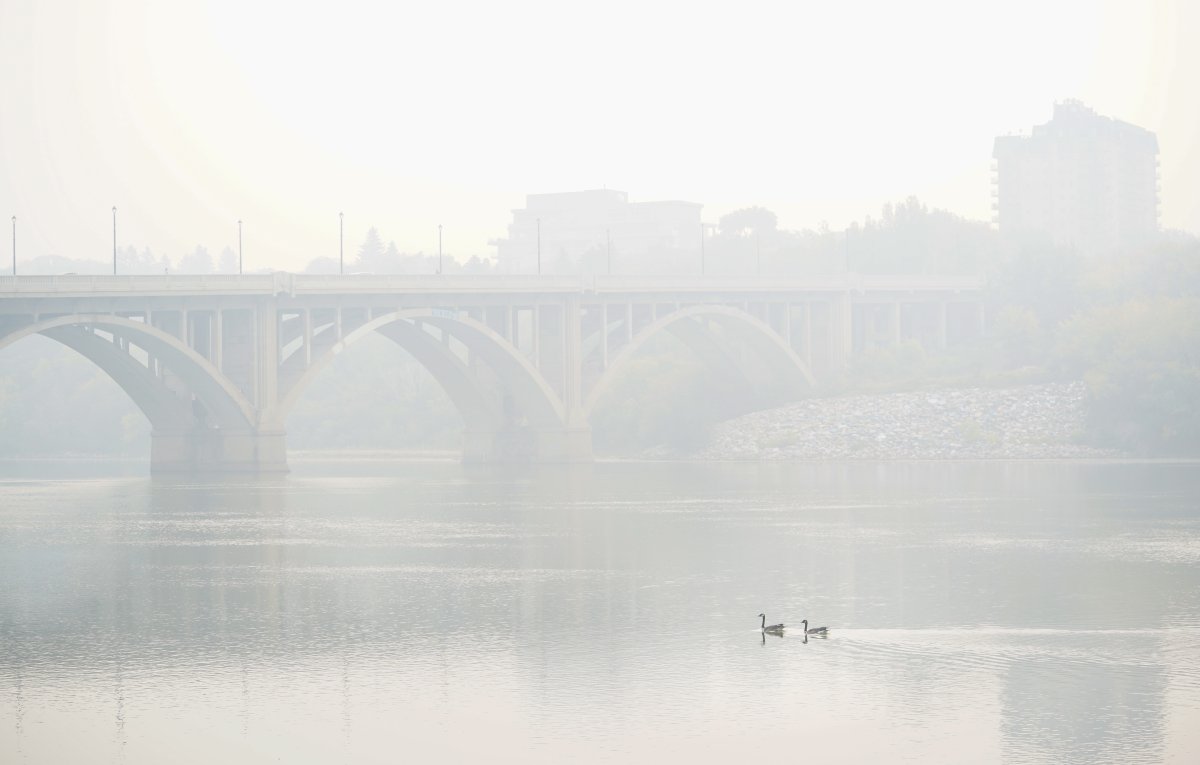Canadians’ personal exposure to wildfire smoke is up 220 per cent over the last two decades, a new report reveals.

Data from the 2023 Report of the Lancet Countdown also showed that from 2018 to 2022, the average Canadian experienced more than two days of exposure to “very high or extremely high wildfire danger” — a 116 per cent increase relative to a 2003-07 historical baseline. That baseline was also used to calculate the wildfire smoke exposure data.
The Canadian statistics were published in a policy brief in partnership with organizations like the Canadian Medical Association (CMA) on Wednesday.
“While the effects of climate change have been felt over the last many years, 2023 has been the worst on record, showcasing the effects of a warming climate and what we can expect for the future if we don’t start to reduce our greenhouse gases now,” Kathleen Ross, president of the CMA, told Global News.
“We’ve certainly seen rising health impacts related to climate change, and it’s time now that we actually focus in and start framing the climate change impacts as a human health crisis.”

In general, the Lancet report suggests that on average, people globally were exposed to six more days of very high or extremely high wildfire danger in 2018-22 compared with 2003–07, with an increase observed in 57 per cent of countries, and no change or a decrease found in the rest.
When compared with 1995 to 2014, the number of days of exposure to very high or higher wildfire risk is projected to increase by approximately nine extra days per person globally (an 11 per cent increase) by the middle of the century.
That factors in both a scenario compatible with limiting global temperature rise to 2 C, and in a scenario in which no further mitigation occurs, the study suggests.
Towards the end of the century, a scenario with no further mitigation is projected to result in 27 more days of exposure than in 1995 to 2014.
What makes up wildfire smoke?
Wildfire smoke consists of a collection of different gases and particles, and one in particular that is very harmful to human health is called PM 2.5.
The Lancet report indicated PM 2.5 concentration would be five per cent higher in the no-further-mitigation scenario than in a scenario compatible with 2 C of heating by 2041–60, but 50 per cent higher by 2081–2100 assuming no further adaptation.
Wildfire smoke particles are “small, tiny things that you can potentially inhale into your lungs and cause irritation and inflammation,” said Dr. Theresa Tam, Canada’s chief public health officer, on June 19.
“There’s certainly a correlation between fine particle inhalation and lung problems and airway problems such as asthma, chronic obstructive airways disease exacerbations, bronchitis and pneumonia and although the data is still somewhat mixed, there could also be an impact on your cardiovascular system.”

The Lancet report, which was published Tuesday, did not include data from 2023 — the worst wildfire season in Canadian history.
A record 18.5 million hectares of land was torched this year, according to the Canadian Interagency Forest Fire Centre. Wildfire smoke spread throughout the country, prompting numerous air quality warnings. It even spread to cities in the United States, and crossed the Atlantic Ocean into parts of Europe.
“Those that are most vulnerable are people with preexisting conditions, people over 65 and those under a year; smoke definitely causes exacerbations in things like asthma and COPD (chronic obstructive pulmonary disease), but also associated with worsening cardiac conditions,” Ross said.
“The mental health impacts are not insignificant. Staying inside, especially if you’re a senior — losing that social contact is a challenge, but the climate anxiety weighs heavily on our population, particularly on our youth, and this is obviously affecting our overall sense of well-being as well.”

What can governments do?
The policy brief makes several recommendations on how to deal with wildfires and their impacts on human health in the future.
It suggests governments improve emergency response systems for extreme weather events, and involve Indigenous knowledge and preparedness, as well as local populations, in developing equitable response policies and evacuation plans.
Furthermore, it suggests a transition to a culture of supporting resilient forest ecosystems rather than fire suppression by supporting prescribed burns, planting biodiverse forests and more.
Also, it says governments should develop better practices for communicating health risks associated with air quality indexes to better inform the public and institutions like schools and daycares.
“There’s no question that we need to act now to reduce our dependency on carbon emitting fuels. We need to look at doing practices that are much healthier for us personally. A plant-based diet can actually help to reduce greenhouse gases, looking at our personal transportation in a more active way and shifting away from those greenhouse gases that are driving climate change,” Ross said.
“Certainly, at the CMA, we’re focusing on drilling down into education processes for physicians and for health-care systems, but education for the general population is going to be needed if we are going to mobilize our government into actions to change our future to a healthy and sustainable future for all Canadians.”






Comments